
Which of the following would probably show the velocity-time graph for a body whose acceleration time graph is shown below?
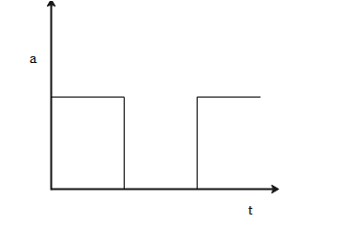
A.

B.
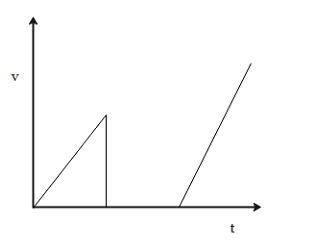
C.
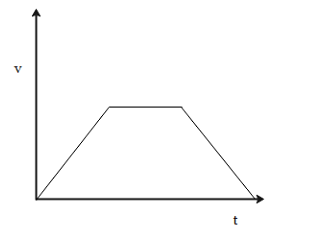
D.
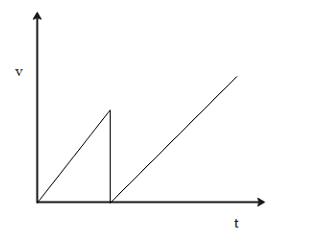





Answer
557.7k+ views
Hint: We need to use the fact that the velocity can be obtained by integrating the acceleration with time. Since integration involves the area under the curve, we need to analyse the variation of area under the curve of the acceleration-time graph to obtain the velocity –time graph.
Complete step by step answer:
We know that acceleration is equal to the derivative of velocity with respect to time. So, the velocity can be obtained by taking the time integral of acceleration.
\[
a = \dfrac{{dv}}{{dt}} \\
v = \int {adt} \\
\]
Therefore, we need to study the area under the curve for the acceleration-time graph in order to obtain the velocity time graph.
Consider the given plot for acceleration and time.
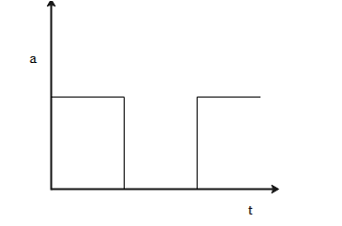
We can make the following observations for the area under the curve which represents the variation of velocity with time.
1. As we go from O to a, we notice that the area under the curve goes on increasing linearly. Therefore, from O to a, the velocity increases linearly.
2. At the area becomes zero and stays zero upto b. This means that acceleration is zero and corresponding to it the velocity will remain constant.
3. From b, the area starts increasing and beyond b, the area increases linearly just like the first case. So, after point b, the velocity increases linearly.
Based on these observations, we can have the following variation of velocity with time.
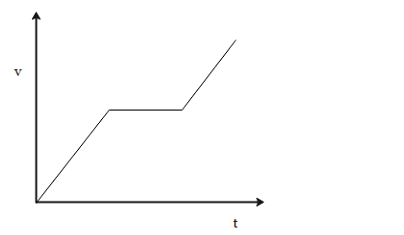
Based on this, the correct answer to the question is option A.
Note:
It should be noted that in order to obtain a curve for a quantity based on the curve for the related quantity, first we need to know how they are related to each other. In case if we had to obtain a plot for acceleration from velocity then we know that acceleration is equal to the time derivative of velocity. Then we study the slope of the velocity-time graph.
Complete step by step answer:
We know that acceleration is equal to the derivative of velocity with respect to time. So, the velocity can be obtained by taking the time integral of acceleration.
\[
a = \dfrac{{dv}}{{dt}} \\
v = \int {adt} \\
\]
Therefore, we need to study the area under the curve for the acceleration-time graph in order to obtain the velocity time graph.
Consider the given plot for acceleration and time.

We can make the following observations for the area under the curve which represents the variation of velocity with time.
1. As we go from O to a, we notice that the area under the curve goes on increasing linearly. Therefore, from O to a, the velocity increases linearly.
2. At the area becomes zero and stays zero upto b. This means that acceleration is zero and corresponding to it the velocity will remain constant.
3. From b, the area starts increasing and beyond b, the area increases linearly just like the first case. So, after point b, the velocity increases linearly.
Based on these observations, we can have the following variation of velocity with time.

Based on this, the correct answer to the question is option A.
Note:
It should be noted that in order to obtain a curve for a quantity based on the curve for the related quantity, first we need to know how they are related to each other. In case if we had to obtain a plot for acceleration from velocity then we know that acceleration is equal to the time derivative of velocity. Then we study the slope of the velocity-time graph.
Recently Updated Pages
Why are manures considered better than fertilizers class 11 biology CBSE

Find the coordinates of the midpoint of the line segment class 11 maths CBSE

Distinguish between static friction limiting friction class 11 physics CBSE

The Chairman of the constituent Assembly was A Jawaharlal class 11 social science CBSE

The first National Commission on Labour NCL submitted class 11 social science CBSE

Number of all subshell of n + l 7 is A 4 B 5 C 6 D class 11 chemistry CBSE

Trending doubts
What is meant by exothermic and endothermic reactions class 11 chemistry CBSE

10 examples of friction in our daily life

One Metric ton is equal to kg A 10000 B 1000 C 100 class 11 physics CBSE

1 Quintal is equal to a 110 kg b 10 kg c 100kg d 1000 class 11 physics CBSE

Difference Between Prokaryotic Cells and Eukaryotic Cells

What are Quantum numbers Explain the quantum number class 11 chemistry CBSE




